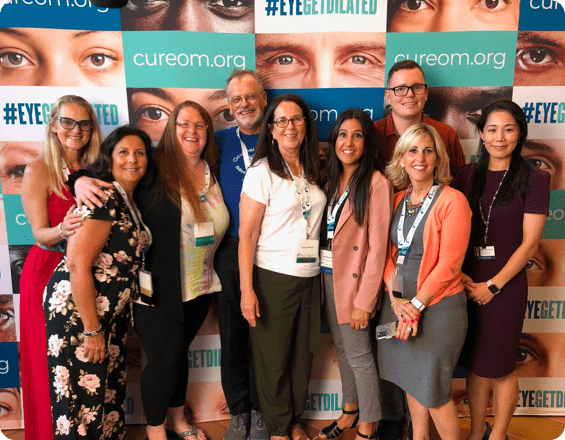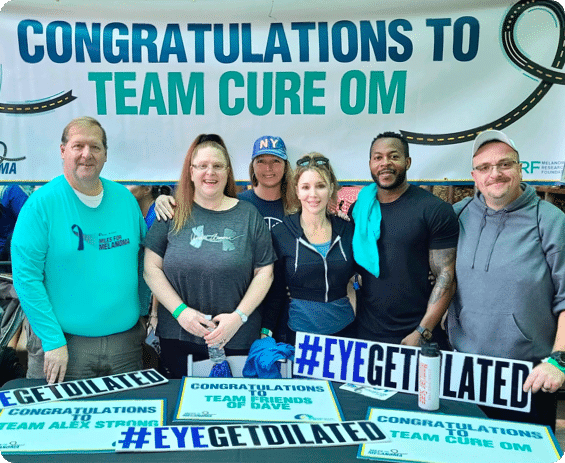Patients & Caregivers
CURE OM

About the MRF’s CURE OM Initiative
CURE OM (the Community United for Research and Education of Ocular Melanoma)
CURE OM is the MRF’s initiative to increase awareness, education and research funding for ocular melanoma, while improving the lives of people affected by this disease. Founded in 2011, the CURE OM initiative excels because of the hard work and dedication of its Patient and Scientific Steering Committees and the generosity of our community. Show your support with a tax-deductible donation to the CURE OM initiative today!

About Ocular Melanoma
Ocular melanoma (OM) is a form of melanoma that develops in the eye and is the most common primary eye tumor in adults. There are nearly 2,000 new cases diagnosed each year in the United States, and it is the second most common melanoma (after cutaneous melanoma).1 Like other melanomas, it begins as melanocytes – the cells that produce the pigment melanin that colors the skin, hair, and eyes, as well as forms moles. If you have ocular melanoma, it is important to know your diagnosis, and treatment options. We have provided resources for people diagnosed with OM. Fifty percent of these cases spread to other parts of the body. When this occurs, it is most often fatal. More information about this type of melanoma is available in our OM Fact Sheet.
Types of Ocular Melanoma
Different types of melanoma of the eye include:
1. Uveal Melanoma – melanoma that arises in the uvea which can be found anywhere in the three layers of the uvea. The uvea is made up of the choroid, iris and ciliary body. Uveal melanoma can form in any of these layers and is named for where it forms
- a. Choroidal melanoma begins in the layer of blood vessels – the choroid – beneath the retina. It is the most common type of uveal melanoma. A 2012 article by the American Academy of Ophthalmology discusses the differences between choroidal nevi and choroidal melanoma.
- b. Iris melanoma occurs in the front, colored part of the eye. Iris melanomas usually grow slowly and do not typically metastasize, or spread, to other parts of the body outside the eye.
- c. Ciliary melanoma occurs in the back part of the eye – in the ciliary body. Melanomas in the ciliary body tend to grow and metastasize to the liver more quickly than iris melanomas.
The conjunctiva is the clear tissue that covers the white part of the eye, as well as the inside of the eyelids. Conjunctival melanoma is very rare. It often appears as a raised tumor and may contain little or even no pigment. Conjunctival melanoma most commonly occurs in the bulbar conjunctiva – the mucous membrane that covers the outer surface of the eyeball. Unlike other forms of ocular melanoma that spread most often to the liver, when conjunctival melanoma spreads, it most often spreads to the lungs.1


Frequency, Incidence & Risk Factors of Ocular Melanoma
6 people per 1 million are diagnosed with eye melanoma in the US every year, while invasive melanoma of the skin occurs in approximately 1 in 50 Americans each year. The incidence of ocular melanoma is similar in other Caucasian populations worldwide. According to a 2017 article published in Clinical Ophthalmology, melanoma of the eye accounts for approximately 3-5% of all melanomas2. Melanoma of the skin increased in frequency over the last several decades, while such a trend is less evident with ocular melanoma.
A variety of risk factors have been identified for ocular melanoma, including light eyes, fair skin type, dysplastic nevus syndrome and the BAP1 mutation. The role of sun exposure as a risk factor for ocular melanoma remains unclear.
Melanoma of the eye tends to occur slightly more often in males than in females and overall risk tends to increase with age.
Citations
- Cheung A, et al. Distinguishing a Choroidal Nevus From a Choroidal Melanoma. American Academy of Ophthalmology. 2012. Accessed August 26, 2020.
- Krantz BA, Dave N, Komatsubara KM, Marr BP, Carvajal RD. Uveal melanoma: epidemiology, etiology, and treatment of primary disease. Clin Ophthalmol. 2017;11:279-289. Published 2017 Jan 31. doi:10.2147/OPTH.S89591
Content last: August 26, 2020
OM Patient and Caregiver Resources
Education
The CURE OM initiative is committed to being the leading provider of ocular melanoma education, resources and support. We partner with OM clinicians and researchers to ensure our OM patient and caregiver community always receives the best, most accurate information.
Through the #EyeGetDilated campaign, CURE OM aims to increase awareness by promoting the importance of early detection. OM is most often detected during a routine, dilated eye exam.
Eye on a CURE: Patient & Caregiver Global Symposium – CURE OM hosts an annual in-person educational symposium with major academic medical centers. These meetings provide an opportunity to learn from leaders in ocular melanoma and network with other OM patients and caregivers. Experts provide updates on diagnosis, treatment, clinical trials and research. View past Symposium recordings and learn about upcoming meetings here:


Find Support
CURE OM offers virtual support groups to individuals diagnosed with primary and metastatic ocular melanoma (OM). These virtual sessions include a mix of educational and wellness information as well as space to connect with other patients for emotional support and companionship. We request that this be a safe space away from judgment or any direct medical advice. For more information about participating in a virtual OM support group please email Miriam Kadosh, Director of Patient Engagement and Education at [email protected].
For more information about additional OM news and events please check out www.melanoma.org.
Find an OM Specialist: Use the Treatment Center Finder to explore ocular melanoma treatment centers. Please note, this is not a doctor recommendation list, simply a list of OM specialists to get you started. The Eye Cancer Network also provides a list of specialists in the US and more than 50 countries around the world.
Get Involved
- Form a CURE OM Miles for Melanoma Team – Raise Awareness and Critical Funds for the OM community
- Attend a Gala
- Start a CommUNITY Fundraiser
- VISION Discussion Boards
- Advocate at the federal and state level on behalf of the OM community

OM Research
The CURE OM initiative is leading the ocular melanoma (OM) field forward. We are committed to accelerating the development of effective treatments and, ultimately, a cure for this disease. Our scientific initiative includes research grants, a patient registry and biannual international scientific meetings. These efforts ensure continued collaboration, support and coordination to move OM research forward.
To date, the MRF has funded over 24 uveal melanoma grants totaling over $2.4 million. To learn about upcoming CURE OM research opportunities, visit our Research Grants RFP Page. To learn more about past uveal melanoma research grantees, visit our Funded Research Page and filter by melanoma type → Ocular Melanoma.
Researchers/Clinicians: to learn more about the CURE OM research opportunities, please contact [email protected].
CURE OM hosts regular global science meetings to facilitate interdisciplinary and innovative collaboration focused on finding effective treatments and, ultimately, a cure for ocular melanoma. Each meeting includes a diverse group of speakers and participants from around the world. To learn more about upcoming & past CURE OM scientific meetings, search our Scientific Meetings Page.


VISION Platform
In 2021, CURE OM launched the VISION Registry, a global patient-reported registry to support advances in ocular melanoma research and treatment development. Designed with the guidance of the Registry Steering Committee, the VISION Registry will inform patient-centered research initiatives focused on policy, patient preferences and standards of care. In addition to collecting invaluable data about diagnosis, disease progression, treatment choice and outcomes, geography and environmental factors, the registry supports the collaboration of patients, caregivers, clinicians, researchers, and the pharmaceutical industry to find a cure together.
In 2023, the MRF’s CURE OM initiative expanded the VISION Registry to create the VISION Platform. The goal of the VISION Platform, is to unite the global ocular melanoma (OM) community by providing an interactive and innovative central place where dispersed patients and caregivers can access disease-specific resources and tools and share their knowledge and experiences with each other and to advance research. The VISION Platform continues to grow in collaboration with OM patient and community input and feedback and currently encompasses the following key components:
The CURE OM Clinical Trial Finder will help you understand which emerging ocular melanoma treatments may be an option for you. Clinical trials offer OM patients the opportunity to receive care that may not yet be standard. You must be logged in via the VISION Registry to access the OM Clinical Trial Finder.





